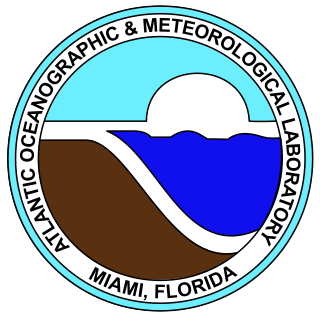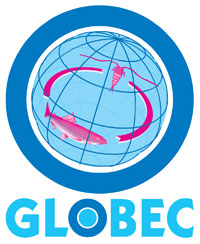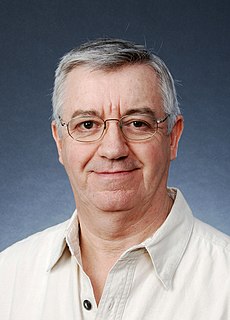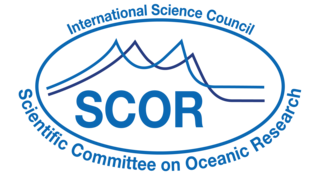
The National Oceanic and Atmospheric Administration is an American scientific and regulatory agency within the United States Department of Commerce that forecasts weather, monitors oceanic and atmospheric conditions, charts the seas, conducts deep sea exploration, and manages fishing and protection of marine mammals and endangered species in the U.S. exclusive economic zone.

The Bering Sea is a marginal sea of the Northern Pacific Ocean. It forms, along with the Bering Strait, the divide between the two largest landmasses on Earth: Eurasia and The Americas. It comprises a deep water basin, which then rises through a narrow slope into the shallower water above the continental shelves. The Bering Sea is named for Vitus Bering, a Danish navigator in Russian service, who, in 1728, was the first European to systematically explore it, sailing from the Pacific Ocean northward to the Arctic Ocean.
The International Council for the Exploration of the Sea is a regional fishery advisory body and the world's oldest intergovernmental science organization. ICES is headquartered in Copenhagen, Denmark, where its multinational secretariat staff of 51 provide scientific, administrative and secretarial support to the ICES community. It was established on July 22, 1902, in Copenhagen.
The Intergovernmental Oceanographic Commission of UNESCO (IOC/UNESCO) was established by resolution 2.31 adopted by the General Conference of UNESCO. It first met in Paris at Unesco Headquarters from 19 to 27 October 1961. Initially, 40 States became members of the commission. The IOC assists governments to address their individual and collective ocean and coastal management needs, through the sharing of knowledge, information and technology as well as through the co-ordination of programs and building capacity in ocean and coastal research, observations and services.

Oceanic and Atmospheric Research (OAR) is a division of the National Oceanic and Atmospheric Administration (NOAA). OAR is also referred to as NOAA Research.

The Atlantic Oceanographic and Meteorological Laboratory (AOML), a federal research laboratory, is part of the National Oceanic and Atmospheric Administration's (NOAA) Office of Oceanic and Atmospheric Research (OAR), located in Miami in the United States. AOML's research spans tropical cyclone and hurricanes, coastal ecosystems, oceans and human health, climate studies, global carbon systems, and ocean observations. It is one of seven NOAA Research Laboratories (RLs).

The Alaska Current is a southwestern shallow warm-water current alongside the west coast of the North American continent beginning at about 48-50°N. The Alaska Current produces large clockwise eddies at two sites: west of the Haida Gwaii and west of Sitka, Alaska.

Global Ocean Ecosystem Dynamics (GLOBEC) is the International Geosphere-Biosphere Programme (IGBP) core project responsible for understanding how global change will affect the abundance, diversity and productivity of marine populations. The programme was initiated by SCOR and the IOC of UNESCO in 1991, to understand how global change will affect the abundance, diversity and productivity of marine populations comprising a major component of oceanic ecosystems.

CalCOFI is a multi-agency partnership formed in 1949 to investigate the collapse of the sardine population off California. The organization's members are from NOAA Fisheries Service, Scripps Institution of Oceanography, and California Department of Fish and Wildlife. The scope of this research has evolved into the study of marine ecosystems off California and the management of its fisheries resources. In 2004, the CalCOFI survey area became one of 26 LTER research sites. This time-series of oceanographic and fisheries data allows scientists to assess the human impact and effects of climate change on the coastal ocean ecosystem. CalCOFI hydrographic & biological data, publications, and web information are distributed for use without restriction under the terms of the GNU Free Documentation License.
IMBeR is a Future Earth-SCOR sponsored international project that promotes integrated marine research through a range of research topics towards sustainable, productive and healthy oceans at a time of global change, for the benefit of society.

Climate change and fisheries affect one another, the relationship between these affects are backed by strong global evidence. Although these effects vary in the context of each fishery and the many pathways that climate change affects them individually. Rising ocean temperatures and ocean acidification are radically altering marine aquatic ecosystems, while freshwater ecosystems are being impacted by changes in water temperature, water flow, and fish habitat loss. Climate change is modifying fish distribution and the productivity of marine and freshwater species.

The Japan Agency for Marine-Earth Science and Technology, or JAMSTEC (海洋機構), is a Japanese national research institute for marine-earth science and technology. It was founded as Japan Marine Science and Technology Center (海洋科学技術センター) in October 1971, and became an Independent Administrative Institution administered by the Ministry of Education, Culture, Sports, Science and Technology (MEXT) in April 2004.
The North Pacific Anadromous Fish Commission (NPAFC) is an international, inter-governmental organization dedicated to the conservation of anadromous fish stocks in international waters of the North Pacific Ocean and its adjacent seas. It was established on 11 February 1992 by the Convention for the Conservation of Anadromous Stocks in the North Pacific Ocean and originally consisted of four member nations: Canada, Japan, Russian Federation, and United States of America. On 27 May 2003, the Republic of Korea acceded to the Convention bringing the current number of Commission members to five. The primary objective of the Commission is to provide a mechanism for international cooperation promoting the conservation of anadromous stocks in the NPAFC Convention Area of the North Pacific Ocean.

CSIRO Oceans and Atmosphere (O&A) is one of the current 8 Business Units of the Commonwealth Scientific and Industrial Research Organisation (CSIRO), Australia's largest government-supported science research agency.

Manuel Barange is a biologist. He is the director of the Fisheries and Aquaculture Policy and Resources Division at the Food and Agriculture Organization of the United Nations. He is an honorary professor at the University of Exeter. Barange was the Deputy Chief Executive Officer and Director of Science at the Plymouth Marine Laboratory and the chair of the scientific committee of the International Council for the Exploration of the Sea. From 2000-2010 he was the Director of the International Project Office of GLOBEC Global Ocean Ecosystem Dynamics, one of the first ever large programmes working on climate change and marine systems.

Trevor Charles Platt was a British and Canadian biological oceanographer who was distinguished for his fundamental contributions to quantifying primary production by phytoplankton at various scales of space and time in the ocean.
Jeffrey Polovina is an American marine scientist. He is known for creating the marine ecosystem model Ecopath.

The Scientific Committee on Oceanic Research (SCOR) is an interdisciplinary body of the International Science Council. SCOR was established in 1957, coincident with the International Geophysical Year of 1957-1958. It sought to bring scientists together to answer key ocean science questions and improve opportunities for marginalised scientists.
Phyllis Jean Stabeno is a physical oceanographer known for her research on the movement of water in polar regions. She has led award-winning research projects in the Arctic and was noted for a distinguished scientific career by the National Oceanic and Atmospheric Administration.












